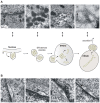Morphogenesis of hepatitis B virus and its subviral envelope particles
- PMID: 19673892
- PMCID: PMC2909707
- DOI: 10.1111/j.1462-5822.2009.01363.x
Morphogenesis of hepatitis B virus and its subviral envelope particles
Abstract
After cell hijacking and intracellular amplification, non-lytic enveloped viruses are usually released from the infected cell by budding across internal membranes or through the plasma membrane. The enveloped human hepatitis B virus (HBV) is an example of virus using an intracellular compartment to form new virions. Four decades after its discovery, HBV is still the primary cause of death by cancer due to a viral infection worldwide. Despite numerous studies on HBV genome replication little is known about its morphogenesis process. In addition to viral neogenesis, the HBV envelope proteins have the capability without any other viral component to form empty subviral envelope particles (SVPs), which are secreted into the blood of infected patients. A better knowledge of this process may be critical for future antiviral strategies. Previous studies have speculated that the morphogenesis of HBV and its SVPs occur through the same mechanisms. However, recent data clearly suggest that two different processes, including constitutive Golgi pathway or cellular machinery that generates internal vesicles of multivesicular bodies (MVB), independently form these two viral entities.
Figures


References
-
- Appenzeller-Herzog C, Hauri HP. The ER-Golgi intermediate compartment (ERGIC): in search of its identity and function. J Cell Sci. 2006;119:2173–2183. - PubMed
-
- Berting A, Hahnen J, Kroger M, Gerlich WH. Computer-aided studies on the spatial structure of the small hepatitis B surface protein. Intervirology. 1995;38:8–15. - PubMed
-
- Blumberg BS, Alter HJ, Visnich S. A “New” Antigen in Leukemia Sera. Jama. 1965;191:541–546. - PubMed

